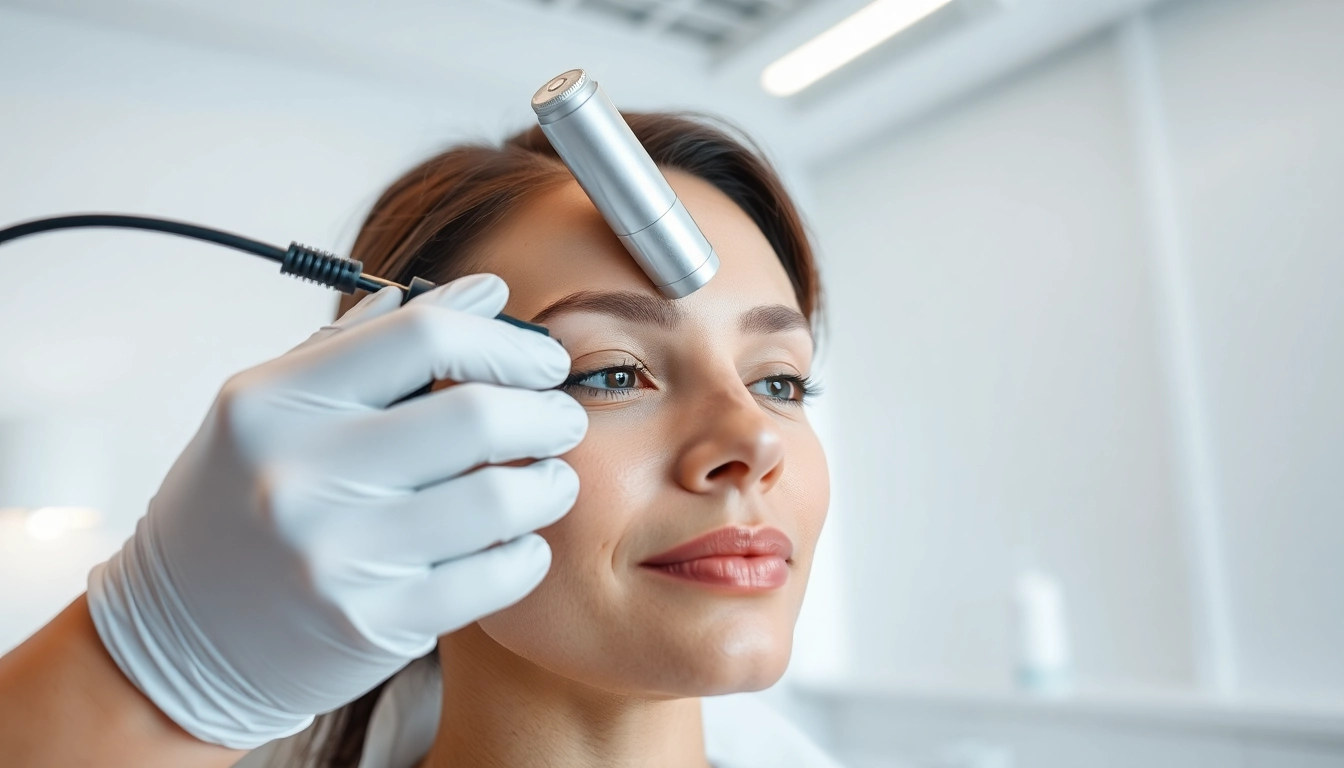Understanding Wrinkle Treatments
What are Wrinkle Treatments?
Wrinkle treatments refer to a variety of cosmetic interventions aimed at reducing the appearance of wrinkles and fine lines on the skin. These treatments can vary in terms of methodologies, effectiveness, and duration of results, but they generally focus on enhancing the skin’s elasticity and overall texture. Whether they are non-invasive, minimally invasive, or surgical procedures, the primary objective remains the same: to restore a youthful appearance and boost the confidence of individuals concerned about aging signs.
Wrinkle treatments can range from at-home products like creams and serums to professional dermatological procedures. It’s essential for individuals to understand the different options available, as this knowledge will empower them to make an informed decision tailored to their skin type and concerns. Proper exploration of these treatments can bring significant improvements in both appearance and self-esteem.
For those considering pursuing a treatment option, exploring various Wrinkle Treatments can provide a clearer picture of what is attainable.
Common Causes of Wrinkles
Understanding the causes of wrinkles is vital in both prevention and treatment. Wrinkles can appear due to a multitude of factors:
- Age: As we age, collagen production and skin elasticity decline, naturally resulting in wrinkles.
- Sun Damage: Ultraviolet (UV) radiation from the sun breaks down collagen fibers and accelerates the skin’s aging process, leading to premature wrinkles.
- Smoking: Nicotine constricts blood vessels, reducing blood flow and depriving the skin of oxygen and essential nutrients, thereby promoting wrinkle formation.
- Repetitive Facial Movements: Frequent expressions, such as frowning or squinting, can lead to fine lines and deeper wrinkles over time.
- Dehydration: Lack of moisture in the skin can make wrinkles more pronounced and contribute to an overall dull appearance.
Recognizing these causes not only helps individuals understand their skin better but also emphasizes the importance of prevention and care to reduce wrinkle formation.
Benefits of Effective Wrinkle Treatments
There are numerous benefits to engaging in effective wrinkle treatments:
- Enhanced Appearance: The most notable benefit is the reduction in the visibility of fine lines and wrinkles, contributing to a more youthful and vibrant appearance.
- Boosted Confidence: Many individuals experience a significant boost in self-esteem after successful treatments, empowering them to feel better in their skin.
- Improvement in Skin Texture: Treatments often enhance the overall texture and tone of the skin, leading to smoother and more radiant skin.
- Long-term Results: With the right approach, some treatments can provide lasting results, minimizing the need for frequent touch-ups.
- Customized Solutions: Effective treatments allow for tailored approaches based on individual skin types and concerns, ensuring optimal results.
Considering these benefits can inspire individuals to explore the myriad of wrinkle treatments available to them, guiding them toward healthier skin.
Types of Wrinkle Treatments Available
Non-invasive Wrinkle Treatments
Non-invasive wrinkle treatments comprise various procedures that do not require surgery and typically involve minimal to no recovery time. These options are excellent for individuals seeking subtle improvements without the need for more aggressive treatments.
- Topical Treatments: Creams and serums containing retinoids, hyaluronic acid, peptides, or antioxidants can diminish wrinkles and improve skin quality when used over time.
- Botulinum Toxin Injections: Commonly known as Botox, these injections temporarily paralyze the muscles responsible for creating wrinkles, particularly in the forehead and around the eyes.
- Dermal Fillers: Hyaluronic acid and collagen fillers can add volume to areas with lost elasticity, smoothing out wrinkles and providing a plumper appearance.
- Laser Therapy: This technique uses focused light energy to stimulate collagen production, improving skin texture and tone.
- Chemical Peels: By applying a chemical solution, the top layer of skin is dissolved, promoting new skin growth and minimizing wrinkles.
Non-invasive treatments can serve as excellent starting points for many individuals, allowing them to achieve visible results without the associated risks of surgery.
Minimally Invasive Procedures
For those seeking more noticeable results than non-invasive treatments can provide, minimally invasive procedures may be the ideal route. These treatments typically involve small incisions and a longer recovery time than non-invasive options.
- Microdermabrasion: This procedure exfoliates the outermost layer of skin to reveal fresher skin underneath, helping reduce fine lines and improve overall texture.
- Radiofrequency Treatments: Utilizing radiofrequency energy, these treatments stimulate collagen production, tightening the skin, and reducing wrinkles.
- Thread Lifts: A technique where temporary sutures lift the skin without damaging it, creating a more lifted and youthful appearance.
- Mesotherapy: Involves injecting vitamins, enzymes, and hormones to rejuvenate and tighten skin, effectively reducing wrinkles.
Minimally invasive procedures often bridge the gap between non-invasive treatments and surgical options, providing substantial results with lesser complications.
Advanced Surgical Options
Advanced surgical options represent the most significant commitment regarding time, financial investment, and recovery but can yield transformative results. These procedures are best suited for individuals with more prominent signs of aging.
- Facelifts: Involves surgically lifting and tightening the skin on the face and neck, addressing sagging, deep wrinkles, and other signs of aging.
- Forehead Lifts: Targets the forehead area to reduce forehead wrinkles and raise sagging brows, providing a more alert and youthful look.
- Laser Resurfacing: A surgical option that utilizes lasers to remove the outer layer of skin and stimulate collagen production deeply, drastically reducing wrinkles.
- Blepharoplasty: Eyelid surgery that removes excess skin and fat around the eyes, minimizing the appearance of crow’s feet and making the eyes look fresher.
While surgical interventions can provide longer-lasting results, individuals should carefully consider their options and consult with qualified professionals before proceeding.
Choosing the Right Wrinkle Treatments for You
Consultation with a Specialist
Choosing the right wrinkle treatment involves thorough consultations with skincare specialists or dermatologists. During these sessions, individuals can express their concerns, discuss their goals, and receive personalized recommendations based on their skin type and conditions.
Specialists may assess factors such as skin texture, elasticity, age, and overall health to tailor a treatment plan that best meets individual needs. Open communication about expectations and previous experiences with skincare will help specialists provide the best possible advice.
Evaluating Treatment Options
After consultation, it’s vital to evaluate the recommended treatment options critically. Individuals should consider factors such as:
- Cost: Understanding the financial investment involved and the potential for ongoing costs related to maintenance treatments.
- Recovery Time: Balancing the desired results with personal schedules, as some options may require significant time off for recovery.
- Pain and Side Effects: Evaluating the discomfort and side effects associated with different procedures to make informed decisions.
- Long-term Commitments: Weighing the longevity of results against the frequency of required visits or touch-ups.
Balancing these factors can help individuals make the most informed decision about their wrinkle treatment journey.
Setting Realistic Expectations
One of the most crucial aspects of selecting any wrinkle treatment is setting realistic expectations. Understanding that results vary based on individual skin types and the chosen procedures will help avoid potential disappointment.
Consultants should guide individuals through what they can realistically expect after each treatment, covering timelines for visible results and the potential need for multiple sessions. Furthermore, individuals must recognize that while treatments can yield significant improvements, they should not replace a healthy lifestyle that contributes to overall well-being.
Preparation and Aftercare for Wrinkle Treatments
Pre-treatment Guidelines
Preparation for wrinkle treatments is essential in ensuring optimal results and minimizing potential complications. Recommended pre-treatment guidelines include:
- Consultation: Attend consultations to discuss any medical conditions, medications, or concerns that may affect treatment outcomes.
- Avoiding Blood Thinners: For certain treatments, it is advisable to avoid blood thinners, including alcohol and anti-inflammatory medications, for several days before treatment.
- Skin Care Regimen: Some specialists may recommend adjusting your skincare routine, possibly switching to gentler products in the lead-up to treatment.
- Hydration: Keeping the skin adequately hydrated through drinking water and using moisturizers can enhance treatment results.
Following these guidelines can significantly improve treatment efficacy and overall satisfaction with results.
Post-treatment Care
After receiving wrinkle treatments, proper care is crucial for encouraging healing and achieving the best outcomes. Here are some best practices for post-treatment care:
- Avoid Sun Exposure: Protecting treated areas from sun exposure is paramount. Wearing sunscreen and protective clothing can help prevent complications.
- Hydration: Continuing to hydrate the skin post-treatment contributes to healing and enhances results.
- Avoiding Irritants: After certain treatments, it’s advisable to refrain from using harsh skincare products for a few days, allowing the skin to recover.
- Follow Doctor’s Instructions: Adhering to specific aftercare instructions provided by specialists helps ensure optimal healing and results.
Prioritizing these post-treatment care recommendations can maximize the benefits of wrinkle treatments, allowing individuals to enjoy their revitalized appearance.
Managing Side Effects
While most wrinkle treatments are safe and well-tolerated, some side effects may occur. Common side effects include swelling, bruising, or redness in the treatment areas. Here are strategies for managing these side effects:
- Icing the Area: Applying a cold compress can help reduce swelling and soothe any discomfort.
- Staying Elevated: Keeping the head elevated for a few hours post-treatment can lessen swelling.
- Consulting with a Specialist: If side effects persist or worsen, reaching out for professional guidance is essential to ensure there are no serious complications.
- Patience: Often, side effects diminish with time; remaining patient can help manage expectations.
Implementing these strategies enables individuals to handle side effects effectively and continue enjoying the benefits of their chosen wrinkle treatments.
Long-term Results from Wrinkle Treatments
Monitoring Treatment Effectiveness
Post-treatment, monitoring the effectiveness of wrinkle treatments is crucial for understanding their impact. Regularly evaluating skin changes can help individuals determine if additional treatments are necessary and when they might best fit into their skincare regimen.
Taking before-and-after photos can serve this purpose well, allowing individuals to visually track their skin improvement over time. Additionally, maintaining open communication with skincare specialists ensures continuous support and tailored adjustments to treatment plans as needed.
Maintaining Youthful Skin
Consistency is key when it comes to maintaining youthful skin after undergoing wrinkle treatments. Individuals should adopt a holistic approach that includes:
- Regular Sunscreen Application: Daily sunscreen application protects the skin from UV damage and helps prolong the results of treatments.
- A Healthy Diet: Consuming a balanced diet rich in antioxidants, vitamins, and hydration promotes healthier skin.
- Maintaining a Skincare Routine: Daily skincare that incorporates cleansing, moisturizing, and targeted treatments is essential for ongoing skin health.
- Frequent Professional Check-ups: Regular skincare consultations or visits can help identify when maintenance treatments may be needed.
Integrating these practices into daily life can significantly extend the positive effects of wrinkle treatments.
Future Innovations in Wrinkle Treatments
The field of dermatology is constantly evolving, with ongoing research and advancements paving the way for innovative wrinkle treatments. Technologies like artificial intelligence and regenerative medicine are set to revolutionize approaches to wrinkle treatments, creating more effective, personalized solutions.
Emerging trends in skincare include:
- Biologic Treatments: Utilizing natural components of the body, such as stem cells, to promote collagen restoration.
- Nanotechnology: Advanced delivery systems for topical treatments that enhance penetration and efficiency to yield better results.
- Smart Skincare Devices: Utilizing technology to monitor skin health and recommend treatments based on data-driven insights.
As these innovations develop, individuals can look forward to enhanced options that promise better results with fewer side effects and longer-lasting effects, further enhancing their journey towards youthful skin.



